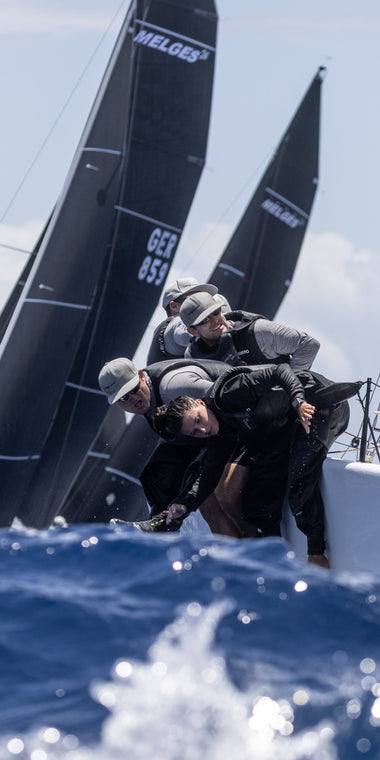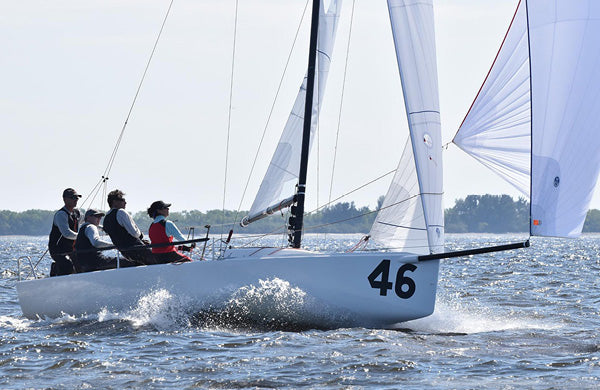SPEED READING: MANAGING YOUR RISKS
SPEED READING: MANAGING YOUR RISKS
Maximizing Your Chances To Make Gains

J/22 World Champion and North Sails Expert Zeke Horowitz explains how you can maximize your chances to gain through smart boat positioning on the racecourse. Sailboat racing is all about controlling what we can—boat speed, boat handling, preparation, and decision-making. But we can’t control everything. So we need to think about ways to manage risk so we can rely on good speed and conservative tactics. In this article, we’ll review strategies you can apply to your position decisions to ensure your boat is in the right place to make gains while avoiding big losses.
Pre Start: “It’s all about the homework”
Get out early to sail most of the first beat and figure out if there are any trends in terms of where the velocity is, how often the wind is shifting, current differences, wave differences, etc. Take note of the range of compass numbers on both tacks so you’ll know right away if you’re lifted or headed. Then, check the starting line. Is there a line sight? Is there a favored end based on compass bearings compared to wind direction?
Now you can relate this info to what you learned sailing upwind and decide on an overall strategy. Is there a persistent shift? Is there a side to race to based on current? Is it oscillating? With all of this info, decide which area of the line to start so you can be ready to make gains right off the line.
If there is a favored end of the line or side of the racecourse, it’s important to start near that end. But if the wind is oscillating, start in an area so you can sail on the lifted tack off the start, regardless of the favored end. If you know the wind is oscillating and in a left phase during the start sequence, the pin will be favored. But since the next shift will be a right phase, it’s probably better to start near the middle or even boat end, because you will have an easier time tacking right away to get on the port lift, and you’ll be closer to the next shift than most competitors. Maybe a few boats that make a risky start at the pin look advantaged early, but you are on the lift, in less traffic and headed towards the next shift, which will be a righty. Now you’re in a position to gain right away.

Beats to Windward: “Game of Thirds”
I like to divvy up the beat into thirds. At the bottom of the beat, it’s all about positioning yourself so you can execute the game plan. If you’re in bad air, you need to decide if tacking for a clear lane is the move or if it’s better to suffer for a while in bad air to get going the direction you want. If there aren’t many shifts, or there isn’t a particular favored side, then lane management is everything and you should not sail for a moment in bad air if you can help it. But if you know you need to get to one side, you may have to sail in bad air to get over to that side at the bottom of the beat.
If the wind is oscillating, you may have to come to terms with the fact that you won’t have much clear air on this beat, because sailing on the lift towards the mark is more important than sailing in clean air. If you know you’re on a lift, duck a boat coming across on the header instead of tacking on its lee bow, even if it’s a big duck. Keep going the right way, staying in position to gain at the next cross.
For the second third of the beat, start looking for opportunities to consolidate. You’ll have an idea of where you stand, and you need to weigh your options for staying ahead of the boats behind you while looking for the opportunity to jump the pack just in front. If you can take separate a bit from any pack of boats, you’ll be able to sail faster. So look for a good opportunity to separate into clear water and avoid being the boat going slow in the middle of the pack.
Most importantly, look up the course past the laylines and start developing a strategy for the top of the beat. If you want to get to a certain side for the last portion of the beat, be disciplined about lee-bowing packs or taking smart ducks to ensure you’ll be one of the first to get out there. Also, look for opportunities to consolidate any gains you’ve already made on packs so you can put them in the bank.
As you near the top of the beat (the final third), think about what the last shift or pressure advantage will be. Often, you can make gains getting to the edges at the top, avoiding the cluster in the middle. As the fleet gathers under the top mark, the wind velocity dies there under “the blob.” Be a little more on an edge, and you’ll have an opportunity to gain. If you’re not in the lead pack, think about the boats that will round ahead and try to avoid that traffic. If possible, also try to avoid getting to a layline too early; if the wind shifts, you won’t make any gains.
Finally, as you approach the weather mark, start developing a downwind strategy. Will there be a long jibe? Is there a pressure or current advantage? Are you rounding in a shift that will dictate the favored jibe right away? Being decisive here can help you jump that pack just in front of you!

Runs to Leeward: “The Train and Making Gains”
The top third of the run is all about escaping from the top mark. If it’s the first weather mark, the traffic of boats still going upwind and the “blob” representing the mass of the fleet as a whole make the area directly under the mark a no-go zone. Unless you see a massive right shift or you know the run is going to be all port jibe, do a bear-away set. Jibing early at the first top mark can be tragic, and the smart money calls for a regular bear-away set on starboard.
Keeping that in mind, though, if you’re clued into the last shift or the position of the leeward mark and you know port jibe is going to be strong, then don’t hesitate; call the jibe set and jump the boats around you so you can be the first on the favored jibe heading down the course.
On the other hand, if you feel the left side of the course is favored and you want to stay on starboard, then commit early to the high lane around the weather mark so you don’t risk getting rolled and forced the wrong way.
Things usually settle in by the second third of the run and you can focus on speed and positioning. Manage your lane behind you to always have clear air, but when it is time to jibe, position yourself to make gains by sailing artificially low for a few moments, moving the trailing competition high of you. While it looks like they are creeping up to get on your breeze, you jibe into clearer air, setting yourself up for the last phase of the run.
The most important thing to decide in the last third of the run is where you want to be for the next beat. If you know you have to go to one side, then that dictates the gate mark you’ll round. If it’s not clear, then try to observe if there is a favored gate (one more upwind than the other), and if that isn’t clear either, decide if one gate will provide a cleaner escape—fewer boats coming down that side of the course giving you bad air as you turn upwind.
You also need to position yourself relative to the nearest boats so you can have a clean rounding. Try to get to the inside of any packs to get mark room. Or look for the chance to split from the pack or the boat rounding just in front of you so that you have less traffic and more clear air as you round. If you’re in a pack of four, and three boats are going to the same gate mark, it usually pays to go to the opposite gate with more speed and clearer air. Even if you want to go the other way, you can come around and tack fairly soon. Now you’ve avoided rounding in a pack and you’re still going the right way. Rather than being in a position where you’ll likely lose distance on that pack, you’re positioned to make another gain. Just make sure you’re not sailing straight into a blob of boats coming downwind with spinnakers!
The name of the game here is being able to decide when the opportunity is to “stay on the train” to avoid a loss and balancing that with positioning the boat on the train so that you’re more likely to gain than lose. Above all else, none of this will matter if you don’t take the time to develop good speed. Good luck this season!




























